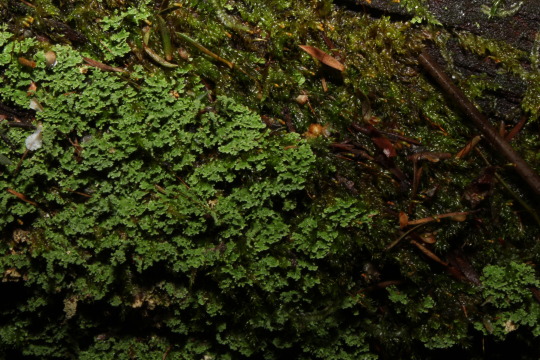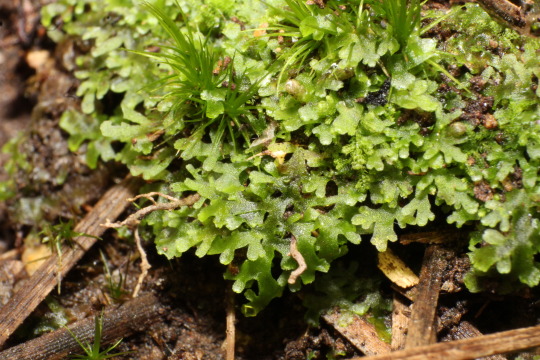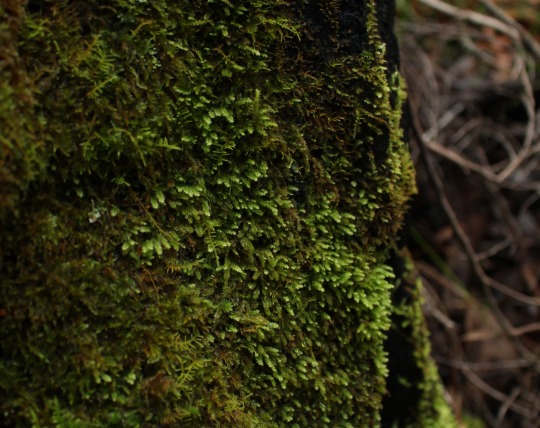#epiphtye
Explore tagged Tumblr posts
Photo






Convergent geometry in unrelated photosynethics in shadey habitats Lichen: 1: Liverworts: 2, 3, 4 Moss: 5, 6 I love the way these grow.
Layered horizonal shingles/scales like balconies or terraces? How commonly unrelated organisms evolve this kinda design indicates it’s highly effective for shadey damp slopes/walls, you can see this everywhere after you start to look. ferns on cliffs, epiphtyes on trees, an alien world would definately have these shapes. I wonder what the forces that are at work are? Which combinations dominate to produce this shape?
the most obvious are the ones perpendicular to the plane they grow on. The light source is up, gravity is down. you can see that on the edges of these shinglescales theres a curvature downwards, perhaps the limiting factor for the radius of the protrusion is the strength against gravity? you don’t want to grow long if your ends do not face sun? but the light here is very diffuse so maybe it’s not sun? the fissidens (pocket moss) in particular loves overhangs where theres rock between the top of the leaf and the sun,,, is bouncey light from below a factor?
The fingerworts fascinate me (below)

they are leafy liverworts, they have terete (circular in cross section perpendicular to length) stem thingo with little clawed hand looking leaf structures down itthier length. microscopically they are beautiful and look like a kinda weird seaweed or coral. macroscopically (naked eye) you cannot see the leaves, you can only just make out the branchedness if you are super close, leaves can look like a ultra thin light green fuzz over the surface when dry, when wet the water film holds the whole thing together like a single angluar leaflet/scale, the water tension holes the branches together. I love how despite it;’s microscopic structure being so completely different, when wet (which it often is due to habitat preferences|) it has the same 3rd profile as the lichens and moss and thalose liverworts. Lichen are already always bizzare and more absurd than any organism, I often think that, if I did not see them so often, I would think they were a joke or prank. A fake taxa. fungi and photosymbionts growing together would be frustrating outliers if we still believed life was an organised Grand Plan.many different fungi and photosymbionts independantly deciding to try out lichenisation and then converging on similar plans is a testament to how powerfully successful such an accidental partnership is. I always maintain that if someone wishes to design an alein ecosystem, and make a convincing alien world, they need only to make it out of existing lichen. scale up some cladia repitroa (below)

and you have an alien biota that people will say “that’s impossible/plausible, unconvicing, no living organism could exist like that in reality!” and then you refer them to that it does infact exist. The conventions used in science fiction and speculative biology are lazy and boring, so often are the same tired pine trees with red leaves trotted out, or giant mushrooms, a single lignified trunk is a painful thing to see., pines and dicots have it, do you think an alien planet has pines and dicots? Cycads, Xanthorhea, Yucca, Kingia, Palms, treeferns, these are the way a short small plant figures out how to big and tall, they all did it by themselves! this shows the design is good! one that a speculative organism may chance upon and bolt upon!. Kelp, darwinia, horsetails, these are also how you can get tall, even acuariaceae (admittedly one of the pinophytes) knows how to have a more interesting central support than most speculative trees.
Prototaxites

the first large organism on land, a fungus, likley lichen.
6 notes
·
View notes
Photo

#terrarium #eatableart #epiphtye #gorgeous #nature #delicious #dessert (at Epiphyte Sg)
0 notes